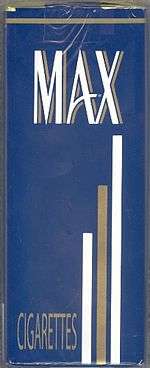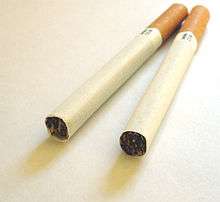Max (cigarette)
Max was an American brand of 120mm cigarettes which was owned and manufactured by the Lorillard Tobacco Company of Greensboro, North Carolina, United States.
 Max 120's pack from June 2010 | |
| Product type | Cigarette |
|---|---|
| Owner | Lorillard Tobacco Company |
| Country | United States |
| Introduced | 1975 |
| Discontinued | Summer 2010 |
| Markets | See Markets |
| Tagline | "Say hello to Max", "Make friends with Max", "Wear A Max Today!" |
| Wikimedia Commons has media related to Max (cigarettes). |
Brand history
Max was launched in 1975 to capitalize on what appeared to be a 120mm cigarettes phenomenon, and was Lorillard's answer to More and Saratoga brands. Sales of Max lagged behind these two brands throughout the 70s and early 80s, but they did do better than Tall 120s, Eve 120s, the Original Virginia Slims 120s (introduced in 1976, in Fresno, CA, and quickly discontinued), and Dawn 120s (also quickly discontinued).
Max maintained popularity over Eve 120s, Capri 120s, and Carlton 120s, but would lag behind Virginia Slims Luxury Lights 120s, introduced by Philip Morris in 1985, with a very aggressive advertising campaign targeting female smokers. Ultimately, in 1993, sales of Max cigarettes would falter a bit more, with the introduction of Misty, a bargain brand, and the only bargain brand which marketed a 120mm length.
Max cigarettes were produced only in a full flavour variety; lights or ultra-lights varieties were not available. They were packaged only in soft packs, and were available only in 120mm length. Both regular and menthol flavours were available.
Max cigarettes were introduced with an attractive packaging, as a slim all-white superlong, specifically catering to upscale, contemporary, and style-conscious female smokers. Max cigarettes were introduced under the Kent name, to capitalize on Kent parentage and subsequent strength, as well as well known perception of effective filtration. However, Max was not specifically introduced as an extension to the Kent line, in an effort to capitalize on Kent rejectors and non-Kent smokers. Intended for the most committed smokers, they had among the highest tar and nicotine content of all cigarette brands.
Eventually, sales flagged in the first decade of the 2000s as the total number of smokers declined and Lorillard marketed the cigarettes half-heartedly, making them difficult to obtain by devotees of the brand. Since Max served a small, niche market to begin with, the decline brought the death knell of the brand in the summer of 2010.
Advertising
.jpg)
Lorillard made various advertising posters and billboards to promote the brand in the 1970s and 1980s. Ads from the 1970s featured stylish women who explained that "The longer they are, the fewer I smoke". Because the statement is completely false, the woman goes on to say, "It s wacky, but it works. Max 120 s take longer to smoke so you don t light up as often".
Other Max ads marketed the brand as sexy, comparing Max cigarettes to an attractive man named Max: "Say hello to Max" ads from 1975 read. "Hello long, lean and delicious". Another ad urged the consumer to "Make friends with Max". Still, other ads concentrated on the fashionable aspect of the cigarette, much like most women's cigarettes. These ads, which reached into the 1980s, presented the cigarette as an accessory for any outfit, featuring fashion-forward models under a slogan advising consumers to "Wear a Max today!". Further, these "Wear a Max" ads spoke to feminine concerns with beauty, claiming that the cigarette was long, lean and great looking, insinuating that by smoking an attractive cigarette, the smoker would be attractive, too.[1]
Markets
Max was mainly sold in the United States, but was also sold in the United Kingdom, Poland, Romania and Israel.[2][3][4]
See also
- Fashion brands
- Smoking culture
- Tobacco smoking
References
- "Stanford Research into the Impact of Tobacco Advertising". tobacco.stanford.edu.
- "BrandMax - Cigarettes Pedia". www.cigarettespedia.com.
- "Max". www.zigsam.at.
- "Brands". www.cigarety.by.
